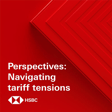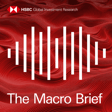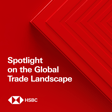Become a Creator today!Start creating today - Share your story with the world!
Start for free
00:00:00
00:00:01

Under the Banyan Tree - Semiconductors: Perspective after the Perfect Storm
Fred Neumann is joined by Head of Asia Technology Research, Frank Lee, for a discussion on the outlook for global semiconductors, where Asia plays by far the largest role of any region.
Disclaimer: https://www.research.hsbc.com/R/51/6H7RLBJ Stay connected and access free to view reports and videos from HSBC Global Research follow us on LinkedIn https://www.linkedin.com/feed/hashtag/hsbcresearch/ or click here: https://www.gbm.hsbc.com/insights/global-research.
Hosted on Acast. See acast.com/privacy for more information.
Transcript
Introduction
00:00:00
Speaker
Welcome to HSBC Global Viewpoint, the podcast series that brings together business leaders and industry experts to explore the latest global insights, trends, and opportunities.
00:00:11
Speaker
Make sure you're subscribed to stay up to date with new episodes.
00:00:14
Speaker
Thanks for listening.
00:00:15
Speaker
And now onto today's show.
00:00:16
Speaker
This is a podcast from HSBC Global Research, available on Apple Podcasts and Spotify.
00:00:22
Speaker
Search for HSBC Global Viewpoint or join us via the HSBC Global Banking and Markets page on LinkedIn.
00:00:29
Speaker
However you're listening, analyst notifications, disclosures and disclaimers must be viewed on the link attached to your media player.
Focus on Asian Semiconductor Market
00:00:45
Speaker
Welcome to Under the Banyan Tree, where we put Asian markets and economics in context.
00:00:49
Speaker
I'm Fred Newman, Chief Asia Economist at HSBC, and today we're focusing on one of the region's pivotal industries.
00:00:57
Speaker
From the phones and computers you're listening on right now to the cars we drive and servers where we store our data, semiconductors are not just an integral part of everyday life, they are also a very significant part of Asia's economy.
00:01:11
Speaker
It's a story of supply chain disruptions and booming demand fueled by the pandemic, with geopolitics, government subsidies and growth opportunities all thrown into the mix.
00:01:20
Speaker
My guest today is head of Asia technology research, Frank Lee.
00:01:23
Speaker
We've got plenty to unpack, so let's get to it.
Asia's Dominance in Semiconductor Manufacturing
00:01:33
Speaker
A few facts to keep in mind while you are listening.
00:01:36
Speaker
Asia is by far and away the global leader for semiconductor manufacturing, with more than 90% of revenue from foundries or fabs, as they are known, being generated in the region.
00:01:47
Speaker
Also, more than 70% of semiconductor capex came from Asian companies in 2021, led by the likes of TSMC in Taiwan,
00:01:55
Speaker
and Samsung in Korea.
00:01:57
Speaker
Even the top US chip makers are heavily exposed to Asia with more than 60% of revenue for Qualcomm, Intel, and AMD coming from the region.
00:02:07
Speaker
Frank Lee joins me now with a big picture view of the sector.
00:02:10
Speaker
Frank, great to have you on the podcast.
00:02:12
Speaker
Thanks, Fred.
00:02:12
Speaker
It's good to be here.
00:02:13
Speaker
So help us set the scene here.
00:02:15
Speaker
We've seen a semiconductor shortage last year, unprecedented by some measures during the pandemic.
00:02:22
Speaker
What really caused that big disruption in the semiconductor space over the past year?
Semiconductor Shortage Explained
00:02:27
Speaker
Yeah, that's a great question.
00:02:28
Speaker
I mean, I don't think anybody really could foresee the magnitude of the shortage.
00:02:31
Speaker
I think basically you had the perfect storm for the overall industry.
00:02:35
Speaker
You had underinvestment by a lot of the mature manufacturing players for many years, and then an unprecedented demand boost
00:02:42
Speaker
In old demand areas that nobody expected to see grow, such as PCs, that grew by 30% in 2020 and in almost 20% in 2021, this is an end market that basically had no growth for 10 plus years.
00:02:54
Speaker
So I think that, along with increasing content growth in areas such as autos hitting at the same time, created basically a huge demand that nobody anticipated that led to this shortage.
00:03:05
Speaker
So you described a perfect storm once in a, I guess, century event, if you will.
00:03:11
Speaker
But we're now coming out the other side.
00:03:13
Speaker
What's the state of the semiconductor sector now?
Softening Demand and Industry Resilience
00:03:16
Speaker
Certainly, we've seen autos decline for electronics.
00:03:20
Speaker
Have backlogs completely evaporated?
00:03:23
Speaker
Or how resilient is the semiconductor sector at the moment?
00:03:26
Speaker
Sure.
00:03:27
Speaker
So just as this shortage was created by an unexpected demand, we are actually seeing the demand picture softening, and it's been a bit staggered.
00:03:34
Speaker
So we've seen consumers lead the decline with a much bigger weakness.
00:03:39
Speaker
So while PCs grew 20% last year, it's now going to fall by more than 20%.
00:03:44
Speaker
So that is basically leading to the beginning of this correction.
00:03:48
Speaker
There are still some areas that were some pockets of strength, such as autos with content growth, but they're not as tight as they were over a year ago as well because you're seeing manufacturers reallocate some of the capacity to the structural growth areas.
00:04:01
Speaker
So the question is going to be, can they continue to fulfill this backlog and for how long, or does ultimately demand in autos also come off?
00:04:10
Speaker
Now, the semiconductor industry is famously very cyclical.
00:04:13
Speaker
You get overinvestment and underinvestment that accentuates the cycle.
00:04:18
Speaker
Have you seen a pullback of investment intentions by semiconductor companies as demand is now cooling?
00:04:24
Speaker
Are they also winding back their investment plans or are they still bullish and going out and building extra capacity?
Measured Investment Amid Cooling Demand
00:04:31
Speaker
Yeah, this is also an interesting question.
00:04:34
Speaker
I think what you're seeing is they are taking a measured approach.
00:04:38
Speaker
We are not seeing a significant cutback in capacity yet.
00:04:42
Speaker
We are seeing some adjustments made in the short term to 2022.
00:04:46
Speaker
But I think we'll get a better clarity and visibility in the next couple of months as companies will have to give their 2023 capex numbers.
00:04:52
Speaker
And that will set the tone in terms of how people view this correction is going to be.
00:04:58
Speaker
So you described kind of a soft landing, if you will, for underlying semiconductor demand and even for investment.
Impact of Supply Chain Disruptions in China
00:05:04
Speaker
But we've seen some headlines around supply chain disruptions in mainland China of late, some factory shutdowns, for example.
00:05:12
Speaker
How disruptive has that been to the semiconductor supply chains globally?
00:05:17
Speaker
Yeah, that's a good question.
00:05:18
Speaker
I think if you look at mainland China, they are a big consumer of semiconductor chips, but less so as a producer.
00:05:26
Speaker
So when you talk about the disruption to the semiconductor supply chain, I don't think we're seeing a significant disruption, but what we're going to see potentially an impact is the downstream assemblers, the end market demand from mainland China is quite significant.
00:05:39
Speaker
So that could ultimately come back to cause a disruption rather than the actual production itself.
00:05:45
Speaker
Of course, when talking about mainland China, we've also seen rising tensions around the semiconductor supply chains.
00:05:52
Speaker
Famously, the U.S. has imposed restrictions on export of technology to mainland China, for example.
00:05:58
Speaker
But really, from an analyst perspective, how disruptive are these restrictions in the near term to China's semiconductor manufacturing industry?
US Export Restrictions and Future Growth
00:06:07
Speaker
Well, Fred, actually, there's been a lot of coverage on this issue.
00:06:11
Speaker
But if you look at the bottom line financial impact, both to U.S. companies and companies in mainland China from these controls or export disruptions, it's actually fairly limited.
00:06:22
Speaker
The first thing is China itself doesn't occupy a huge percentage of the overall manufacturing of semiconductors today.
00:06:29
Speaker
And secondly, the controls that are being put in place in terms of restrictions, they're basically more about future growth, future opportunities.
00:06:38
Speaker
And even the end market, if you look at some of the restrictions being placed around areas such as AI, it's not a big end market demand today.
00:06:46
Speaker
So I think if you look at the downside on earnings to companies today, it's not significant, but it's more about the unknown, the future growth opportunities that could be impacted.
00:06:57
Speaker
And so it's really about developing future technologies then from mainland China and might kind of restrict that particular part.
00:07:04
Speaker
What kind of technologies do you have in mind here where actually these restrictions could restrain China's ability to develop further?
00:07:11
Speaker
Is it artificial intelligence?
00:07:14
Speaker
What kind of areas are affected by these restrictions?
00:07:17
Speaker
Yeah, so if you look at the sensitive areas, it tends to focus on what they call high performance computing, the most advanced processor chips.
00:07:26
Speaker
So the applications are those are going to be used in things like AI or even autonomous driving, which currently today is not a big market of the overall current demand, but it is a big piece of the future growth that everyone's looking at.
00:07:38
Speaker
So this is a long-term issue then for mainland China, but certainly it introduces some risk around supply
Efforts to Diversify Supply Chains
00:07:45
Speaker
chain.
00:07:45
Speaker
Have you seen any evidence of supply chain diversification in the semiconductor space?
00:07:50
Speaker
Is there more production being moved to other markets, say Southeast Asia, for example, or the U.S.?
00:07:57
Speaker
Yeah, I think what you're seeing is, you know, there's two issues.
00:08:00
Speaker
There's the issue in mainland China in terms of their own development going forward and the export controls being put there.
00:08:06
Speaker
And there's also the other issue of other countries trying to reshore their semiconductor manufacturing and diversify some of that risk away from places like Taiwan.
00:08:16
Speaker
But again, this is going to take some time, especially in the advanced process.
00:08:20
Speaker
It's not going to be an easy feat.
00:08:21
Speaker
I don't think you're going to see a very successful reshoring, at least for the next five to 10 years.
00:08:27
Speaker
So while there's going to be incentive to do this, it won't be that quickly.
00:08:31
Speaker
And I think in terms of Southeast Asia, they have a strong history in terms of testing and packaging because of the labor cost advantages.
00:08:39
Speaker
but not so much on the front end, which is a lot more capital intensive.
00:08:43
Speaker
So I don't see the front end manufacturing being moved to Southeast Asia.
00:08:47
Speaker
I think they'll continue to work on the testing and packaging side of it.
00:08:51
Speaker
Thank you very much, Frank.
00:08:53
Speaker
We're now going to take a quick break.
00:08:54
Speaker
We'll be back in a moment to discuss the challenges of shifting semiconductor manufacturing and supply chains.
Challenges in Government Investment Plans
00:09:10
Speaker
Now, Frank, you've looked at the semiconductor market for many years.
00:09:14
Speaker
It must be striking for somebody like you to see the big investment plans that governments have rolled out, subsidies from Japan to the US to other countries.
00:09:24
Speaker
In the big scheme of things, how easy is it really to catch up with this very advanced manufacturing process?
00:09:30
Speaker
Give us a sense of how complicated the process actually is.
00:09:33
Speaker
And can you just throw billions of dollars at it and these new advanced fabs kind of spring up anywhere?
00:09:40
Speaker
I mean, there's going to be a couple of challenges when it comes to recreating this semi-ignited supply chain.
00:09:45
Speaker
The first thing is just the cost itself is going to be a lot more.
00:09:48
Speaker
So what we've seen in the overall industry the last 20, 30 years is all about efficiency.
00:09:53
Speaker
But now in this new world, I think you're going to see inefficiencies, rising costs go up, just labor costs, the cost of building a fab, just a physical shell is all going to be a lot more expensive.
00:10:03
Speaker
The second thing is also the engineering talent.
00:10:05
Speaker
That's something that remains to be seen how much they can replicate that.
00:10:11
Speaker
In the last 30 years, we've seen a lot of the talent pool shifting.
00:10:15
Speaker
You see places in the US where most of the talented people are going into the internet space.
00:10:20
Speaker
They weren't really going into semiconductors.
00:10:22
Speaker
So now we're trying to recreate this environment.
00:10:25
Speaker
I think it's going to take a lot longer than most of the governments realize.
Replicating Taiwan's Technology
00:10:29
Speaker
So if you talk about, say, an example, the most advanced fabrication processes that we have today, I think Taiwan leads probably in that particular area.
00:10:39
Speaker
How long do you think realistically would it take to replicate the same advanced technology?
00:10:44
Speaker
Korea probably is fairly close, but could you see other markets getting to that point?
00:10:49
Speaker
What time frame are we talking about?
00:10:51
Speaker
Is it five, ten years or longer?
00:10:53
Speaker
I think if you look at, one, are you capable of even manufacturing?
00:10:56
Speaker
And secondly, are you going to be efficient in doing it?
00:11:00
Speaker
You look at Taiwan, for example, they've been dominating in the advanced process.
00:11:04
Speaker
They're now recreating some of this in the U.S. as well with their investments.
00:11:09
Speaker
But there also remains questions about how efficient their own fabs in the U.S. is going to be relative to manufacturing in Taiwan.
00:11:16
Speaker
There's a lot of upstream material suppliers that needs to develop as well, and a lot of those are
00:11:21
Speaker
are already developed in Asia.
00:11:23
Speaker
So we need to recreate those in other countries too.
00:11:26
Speaker
So the way you describe this is it's a very sticky process that once you've acquired the talent, the suppliers, the networks, actually you can't really easily move these very advanced manufacturing plants to other places.
00:11:40
Speaker
But we're also looking at an industry where there's new technologies coming through.
00:11:44
Speaker
So we have famously Moore's law, which was the doubling of the number of transistors every two years, which increased the computing power by an enormous amount.
00:11:53
Speaker
Are we getting to an end here?
00:11:54
Speaker
Are there technologies that might disrupt this?
00:11:57
Speaker
Does that open a strategic opportunity for others to jump in with new manufacturing approaches from what we have now?
Future of Semiconductor Technology and Moore's Law
00:12:04
Speaker
Yeah, I mean, I think if you look at, you know, people have talked about the end of Moore's Law for the last 10 years now, but it has continued to extend.
00:12:11
Speaker
You know, the most advanced process today is what they call a 3 nanometer.
00:12:15
Speaker
That will probably be the mainstream of the most advanced process for the next three years.
00:12:20
Speaker
After that, we have a 2 nanometer process that will probably take us over the next 5 to 7 years.
00:12:25
Speaker
So I think if you look at over the next 5 to 7 years, the roadmap is pretty clear.
00:12:31
Speaker
Longer term after that, I think we'll have to continue to see.
00:12:34
Speaker
But somehow, you know, this industry has managed to get efficiencies over time.
00:12:38
Speaker
And I think that will probably still remain the case.
Sector Outlook Amid Geopolitical Risks
00:12:41
Speaker
So thanks, Frank.
00:12:42
Speaker
You're really describing a sector that is going to a soft landing of some sorts, where companies are adjusting to these political uncertainties that are out there, but really also that in many ways it's very sticky.
00:12:54
Speaker
It's very hard to move these plants.
00:12:55
Speaker
And so probably we're not going to see the shape of these semiconductor supply chains move all too much despite all the headline risk in the coming year.
00:13:04
Speaker
So thank you very much for sharing your thoughts today.
00:13:07
Speaker
All right.
00:13:07
Speaker
Thanks, Frank.
Podcast Wrap-up
00:13:13
Speaker
And that's a wrap for today's show and for the year.
00:13:16
Speaker
We'll be back at the start of January with the long-awaited return of my co-host, Harold van der Linde, and we'll look forward to bringing you our outlook for Asian economics and equities in the year ahead.
00:13:27
Speaker
Many thanks for joining us under the banyan tree.
00:13:29
Speaker
Have a great festive season, and we'll see you in 2023.
00:13:36
Speaker
Thank you for joining us at HSBC Global Viewpoint.
00:13:40
Speaker
We hope you enjoyed the discussion.
00:13:42
Speaker
Make sure you're subscribed to stay up to date with new episodes.

















